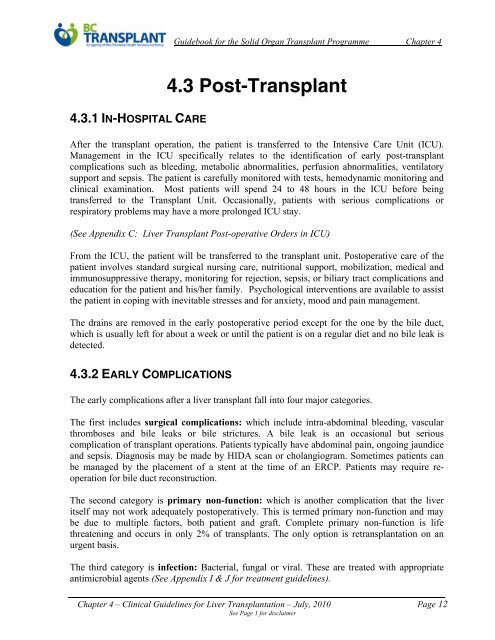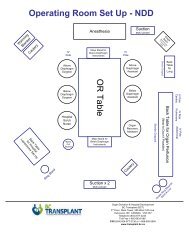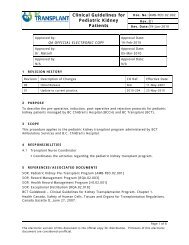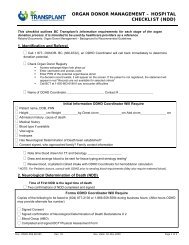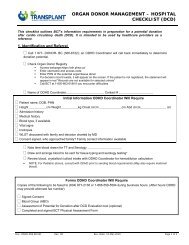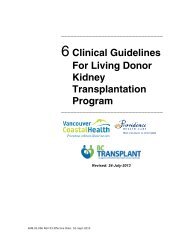4. Clinical Guidelines for Liver Transplantation (PDF) - British ...
4. Clinical Guidelines for Liver Transplantation (PDF) - British ...
4. Clinical Guidelines for Liver Transplantation (PDF) - British ...
You also want an ePaper? Increase the reach of your titles
YUMPU automatically turns print PDFs into web optimized ePapers that Google loves.
Guidebook <strong>for</strong> the Solid Organ Transplant Programme Chapter 4<br />
<strong>4.</strong>3.1 IN-HOSPITAL CARE<br />
<strong>4.</strong>3 Post-Transplant<br />
After the transplant operation, the patient is transferred to the Intensive Care Unit (ICU).<br />
Management in the ICU specifically relates to the identification of early post-transplant<br />
complications such as bleeding, metabolic abnormalities, perfusion abnormalities, ventilatory<br />
support and sepsis. The patient is carefully monitored with tests, hemodynamic monitoring and<br />
clinical examination. Most patients will spend 24 to 48 hours in the ICU be<strong>for</strong>e being<br />
transferred to the Transplant Unit. Occasionally, patients with serious complications or<br />
respiratory problems may have a more prolonged ICU stay.<br />
(See Appendix C: <strong>Liver</strong> Transplant Post-operative Orders in ICU)<br />
From the ICU, the patient will be transferred to the transplant unit. Postoperative care of the<br />
patient involves standard surgical nursing care, nutritional support, mobilization, medical and<br />
immunosuppressive therapy, monitoring <strong>for</strong> rejection, sepsis, or biliary tract complications and<br />
education <strong>for</strong> the patient and his/her family. Psychological interventions are available to assist<br />
the patient in coping with inevitable stresses and <strong>for</strong> anxiety, mood and pain management.<br />
The drains are removed in the early postoperative period except <strong>for</strong> the one by the bile duct,<br />
which is usually left <strong>for</strong> about a week or until the patient is on a regular diet and no bile leak is<br />
detected.<br />
<strong>4.</strong>3.2 EARLY COMPLICATIONS<br />
The early complications after a liver transplant fall into four major categories.<br />
The first includes surgical complications: which include intra-abdominal bleeding, vascular<br />
thromboses and bile leaks or bile strictures. A bile leak is an occasional but serious<br />
complication of transplant operations. Patients typically have abdominal pain, ongoing jaundice<br />
and sepsis. Diagnosis may be made by HIDA scan or cholangiogram. Sometimes patients can<br />
be managed by the placement of a stent at the time of an ERCP. Patients may require reoperation<br />
<strong>for</strong> bile duct reconstruction.<br />
The second category is primary non-function: which is another complication that the liver<br />
itself may not work adequately postoperatively. This is termed primary non-function and may<br />
be due to multiple factors, both patient and graft. Complete primary non-function is life<br />
threatening and occurs in only 2% of transplants. The only option is retransplantation on an<br />
urgent basis.<br />
The third category is infection: Bacterial, fungal or viral. These are treated with appropriate<br />
antimicrobial agents (See Appendix I & J <strong>for</strong> treatment guidelines).<br />
Chapter 4 – <strong>Clinical</strong> <strong>Guidelines</strong> <strong>for</strong> <strong>Liver</strong> <strong>Transplantation</strong> – July, 2010 Page 12<br />
See Page 1 <strong>for</strong> disclaimer


